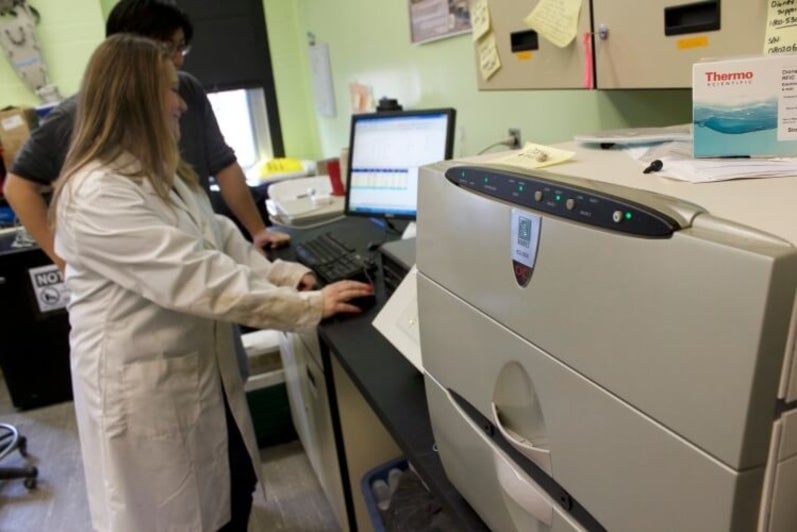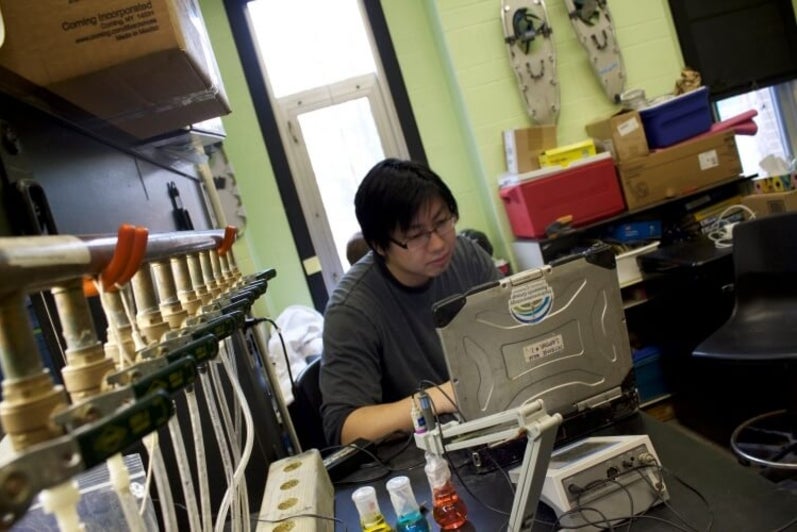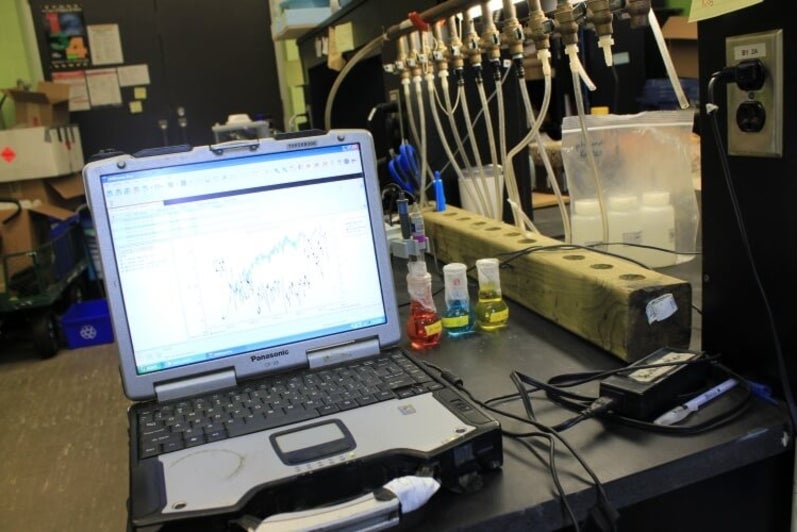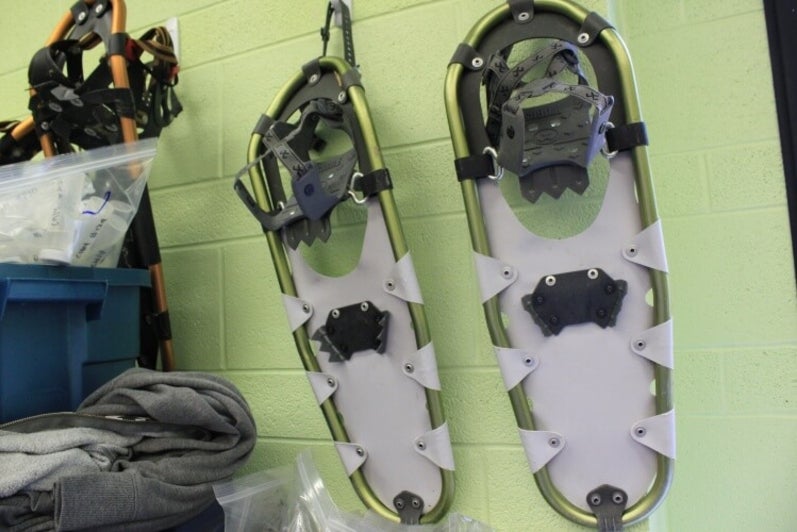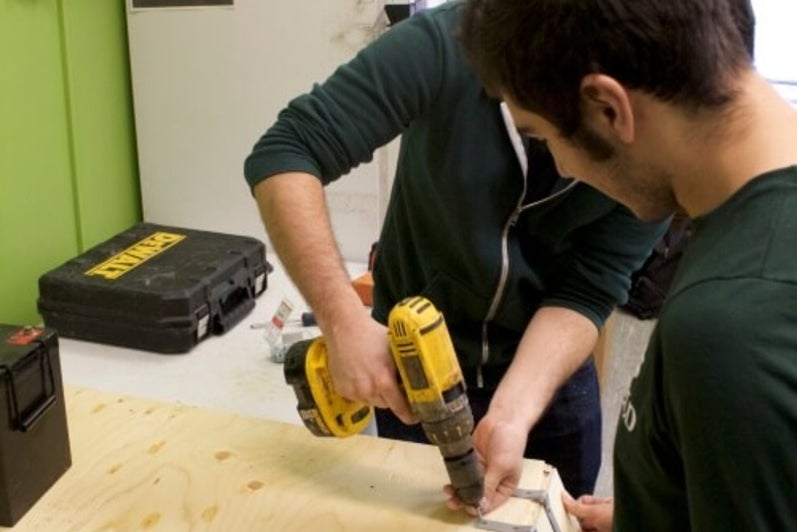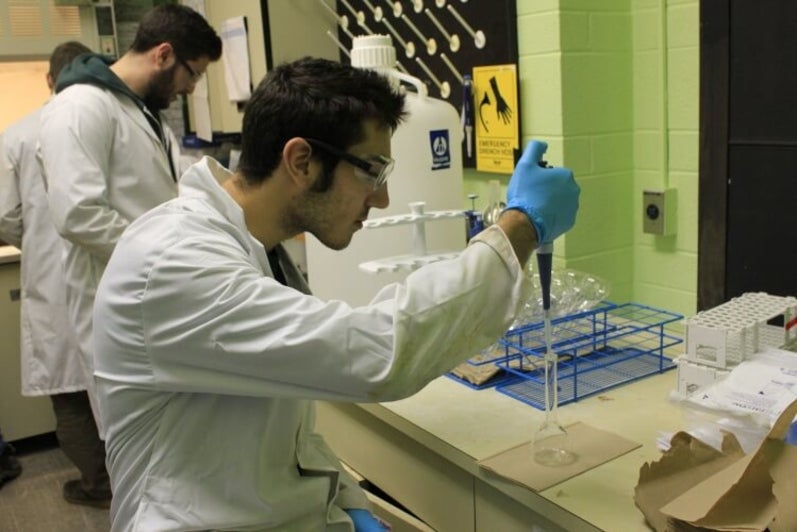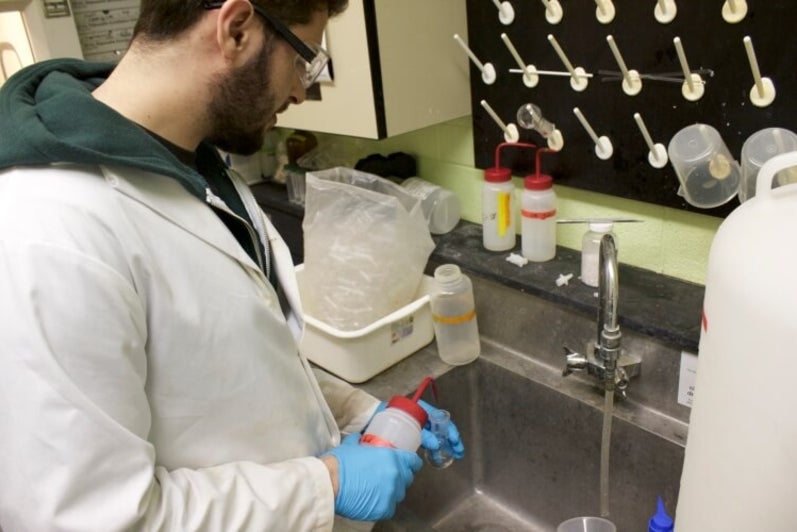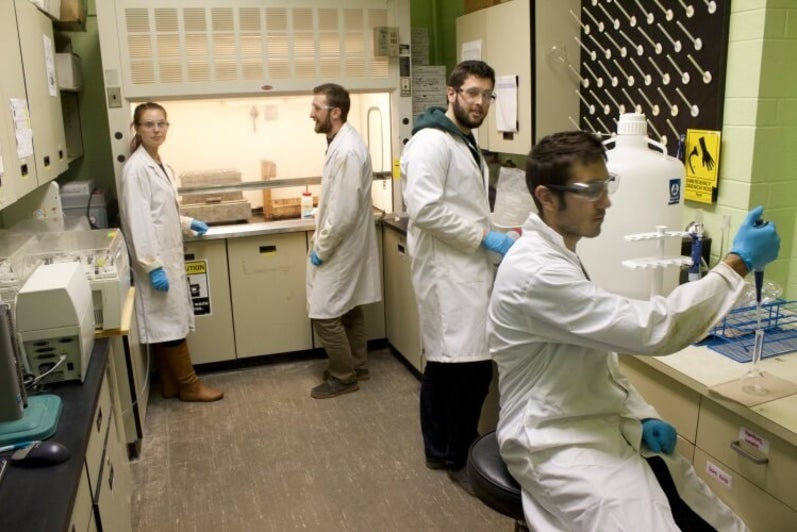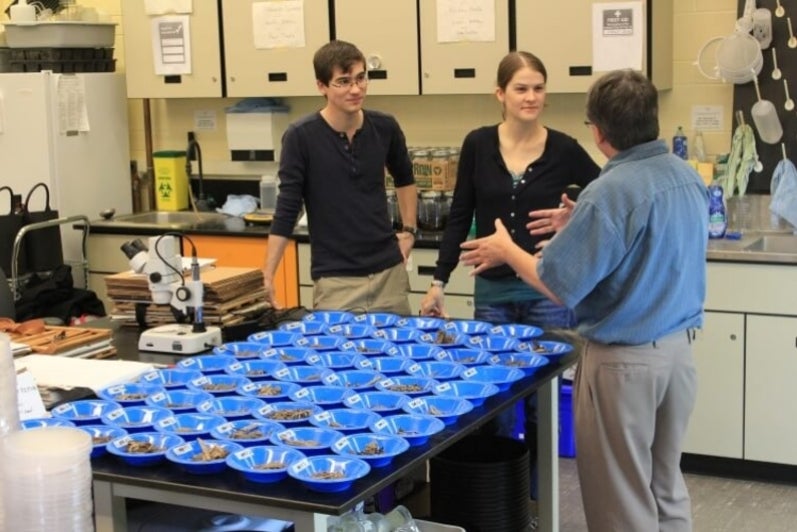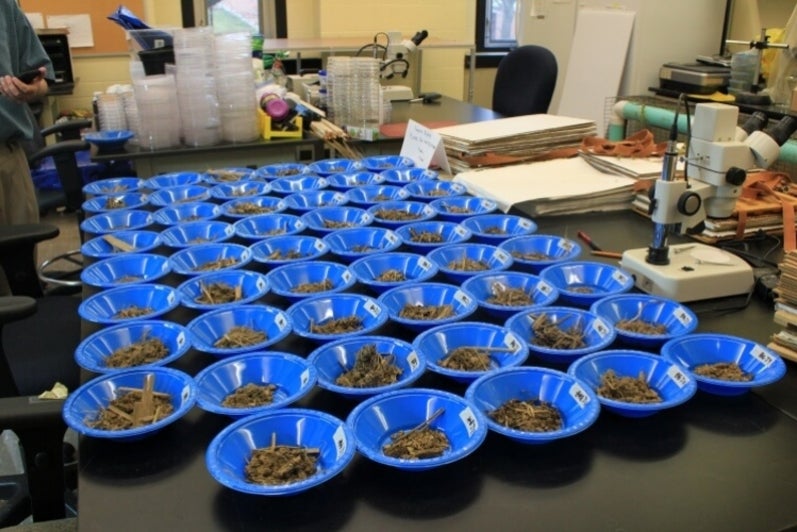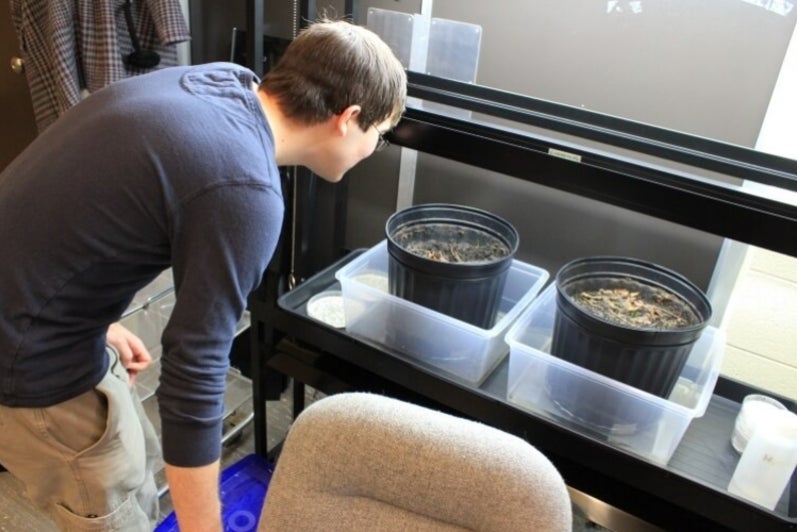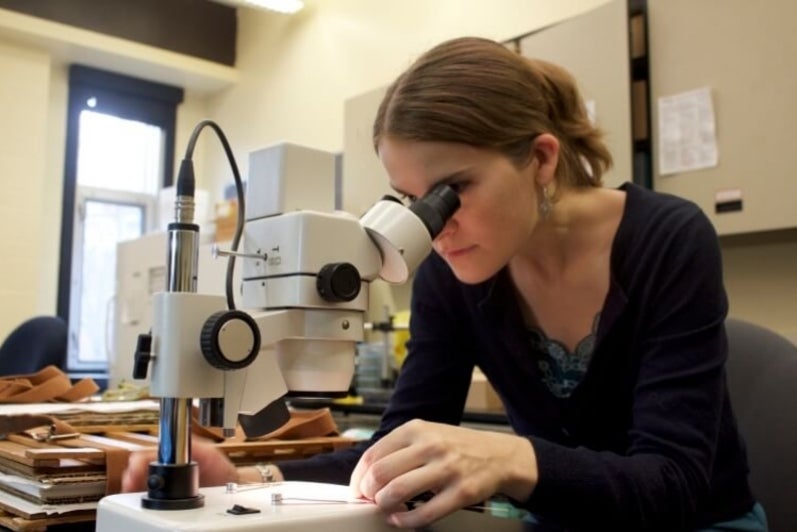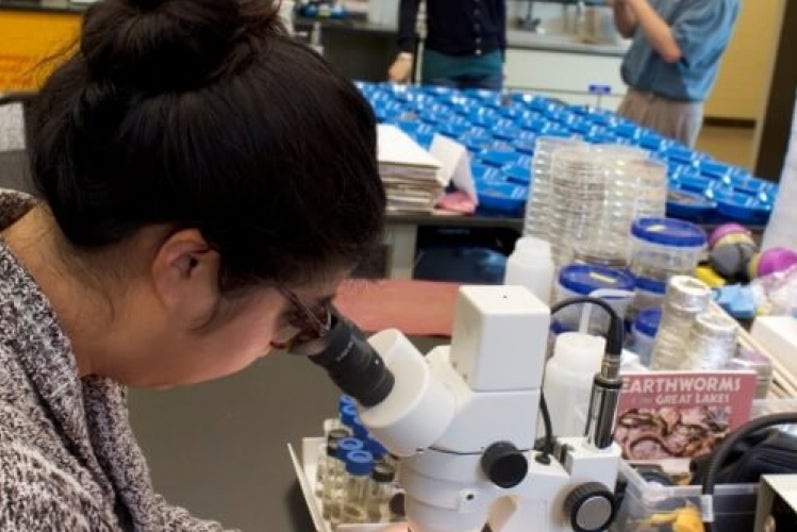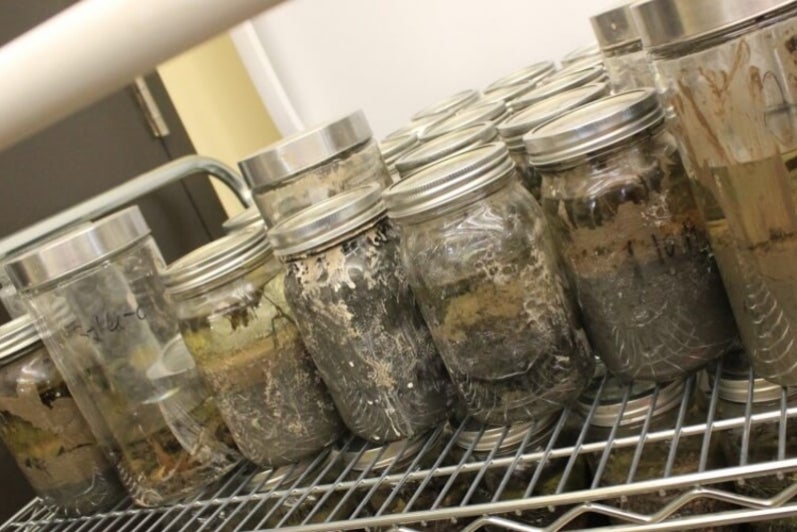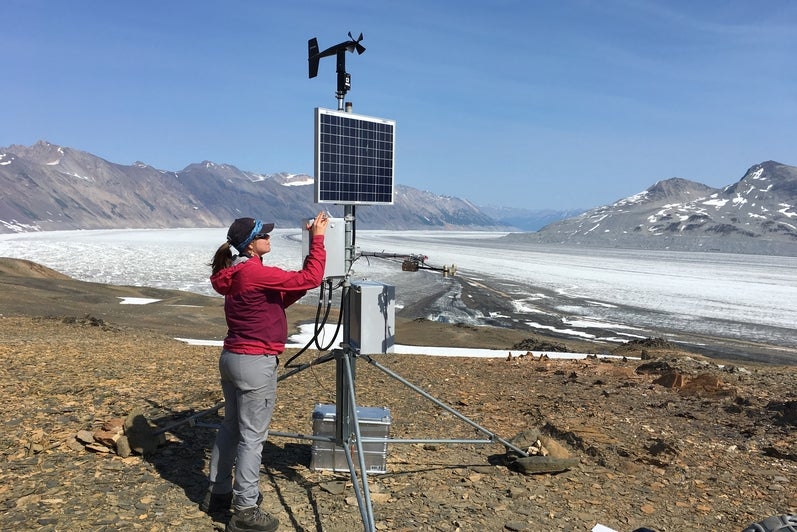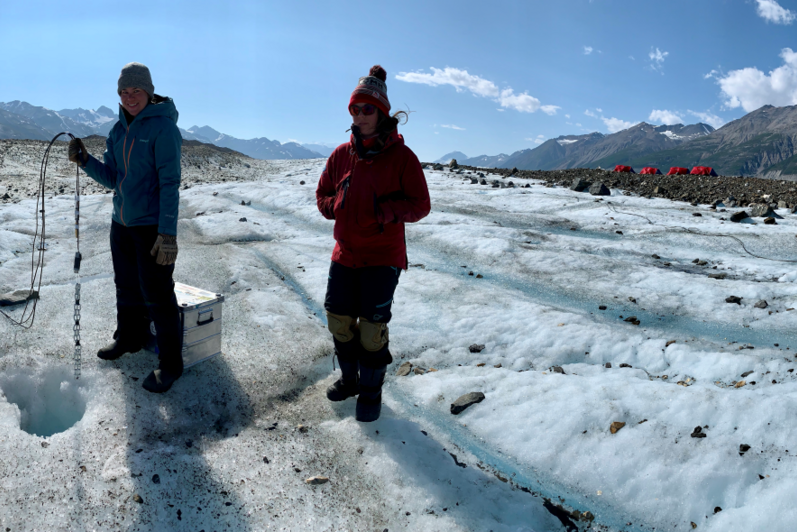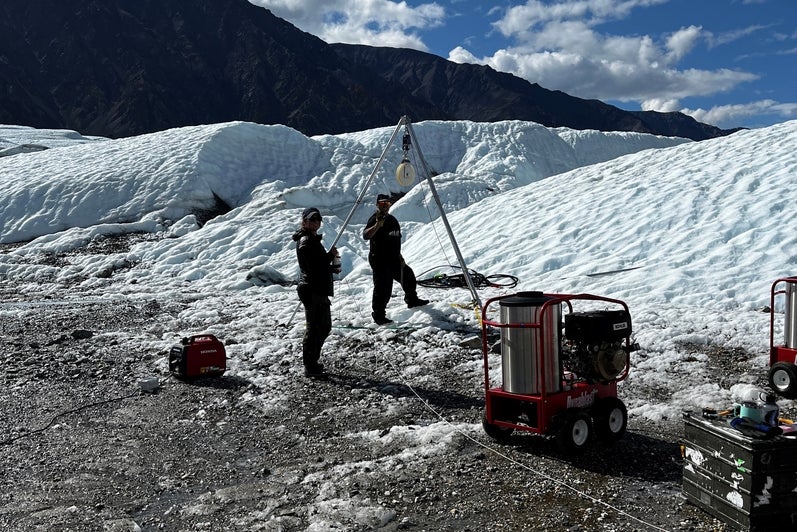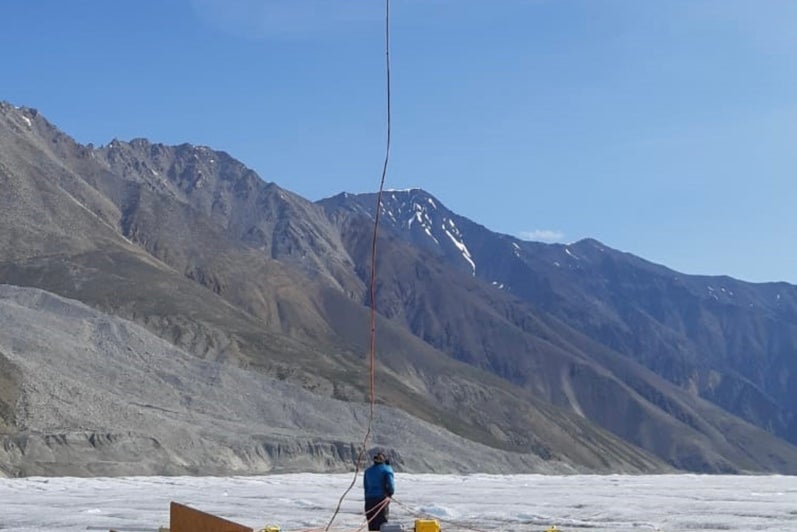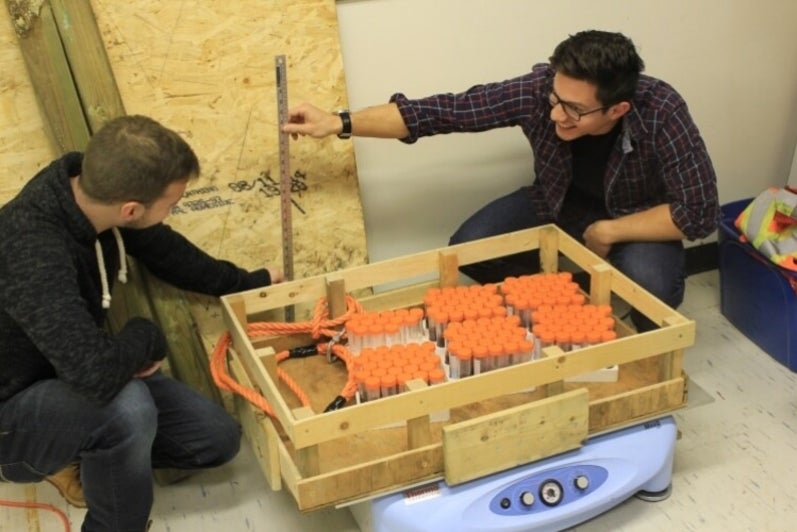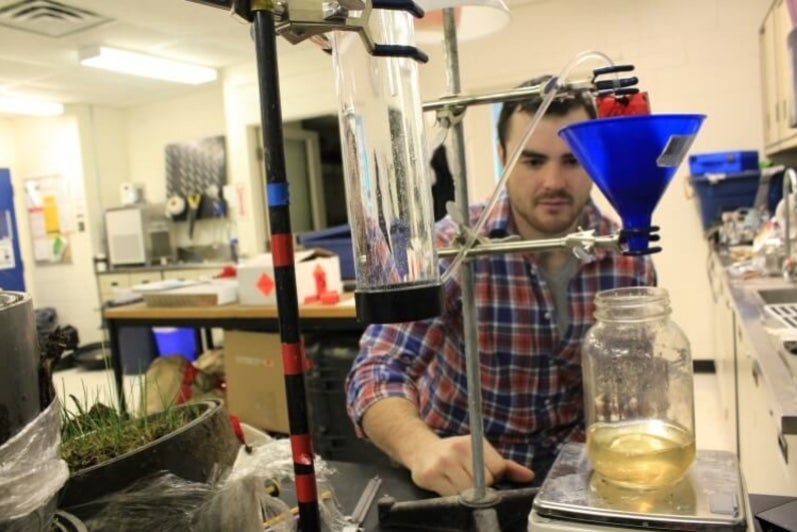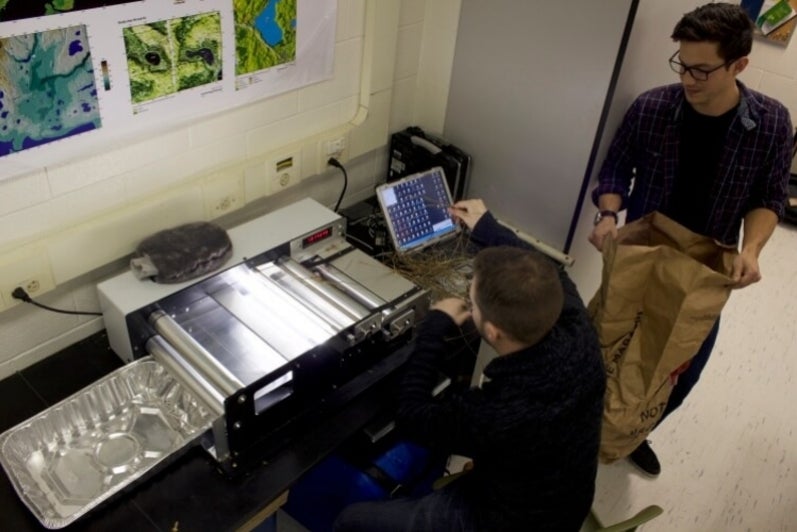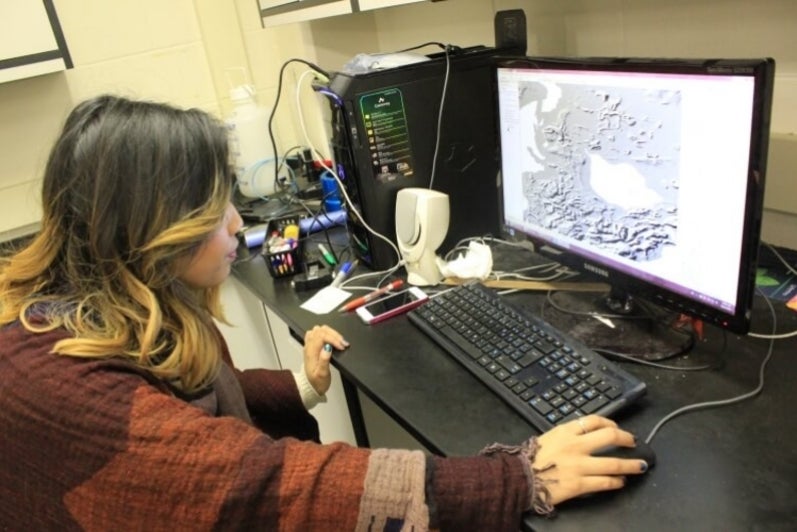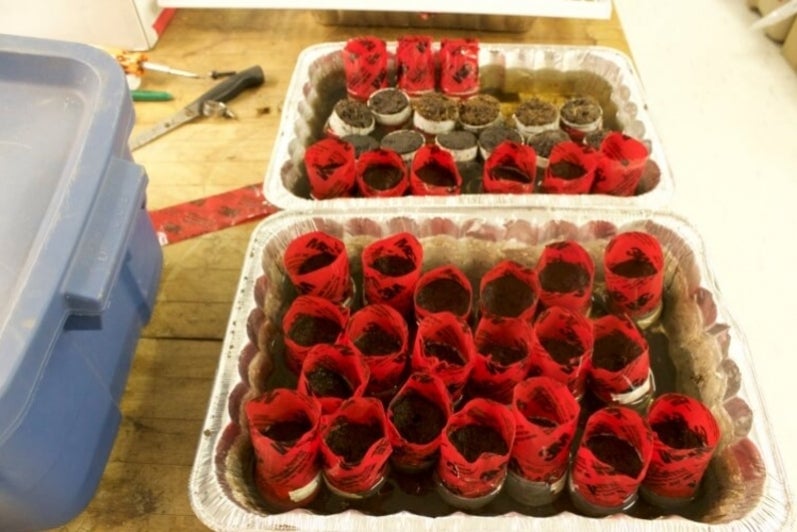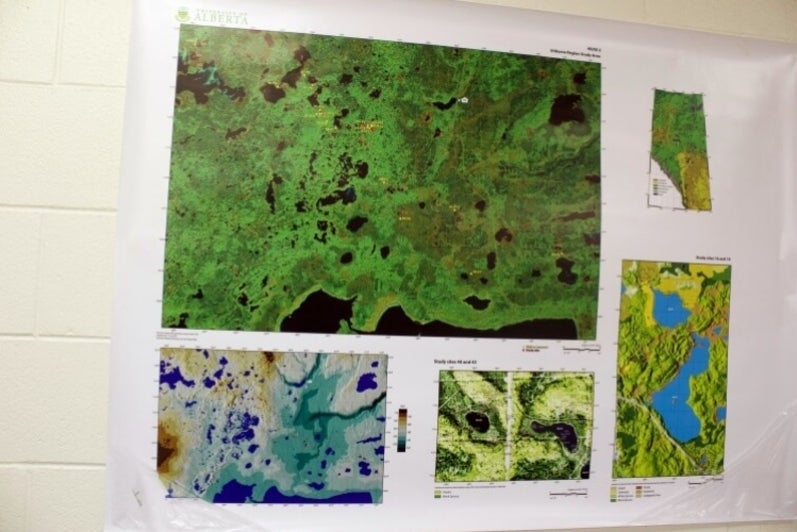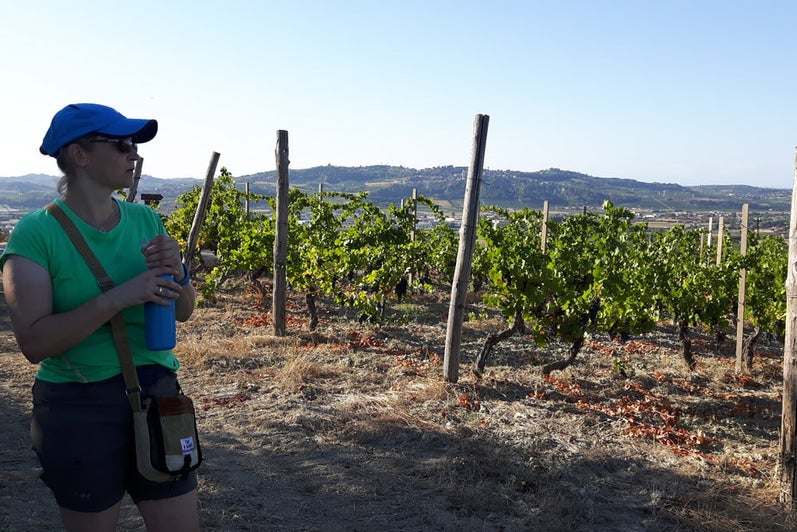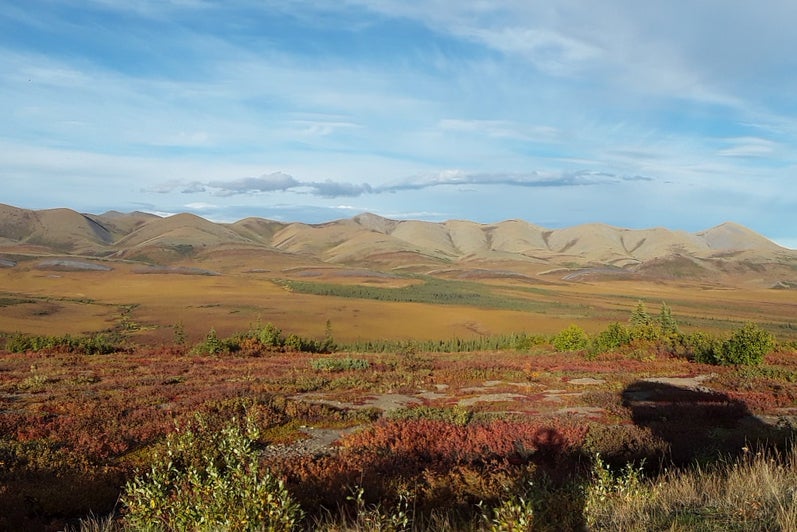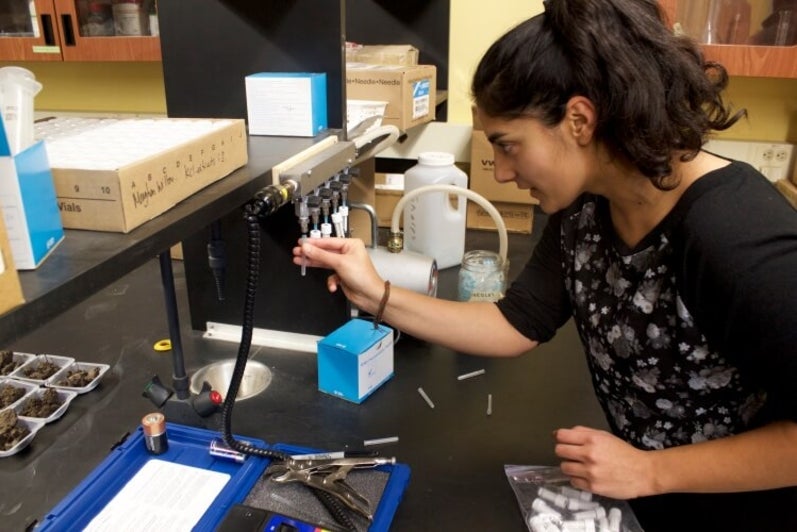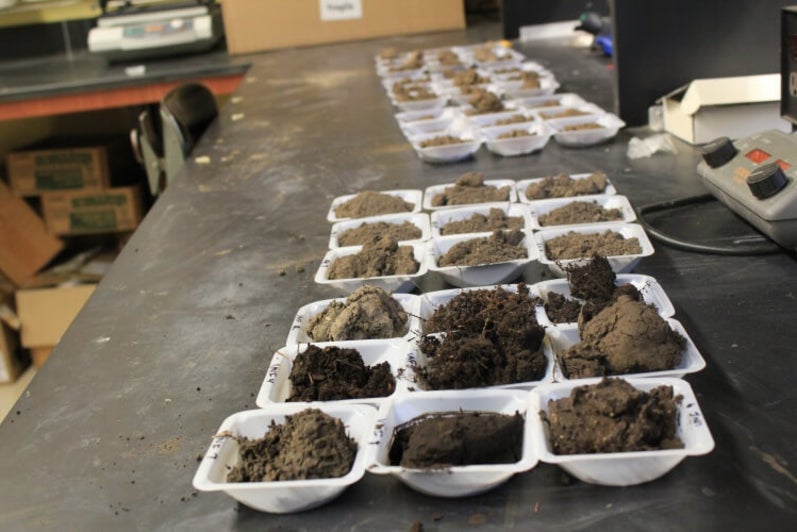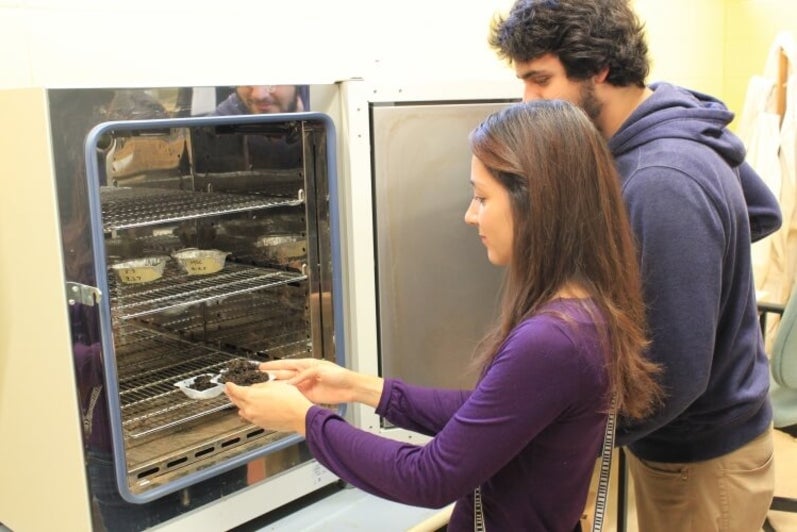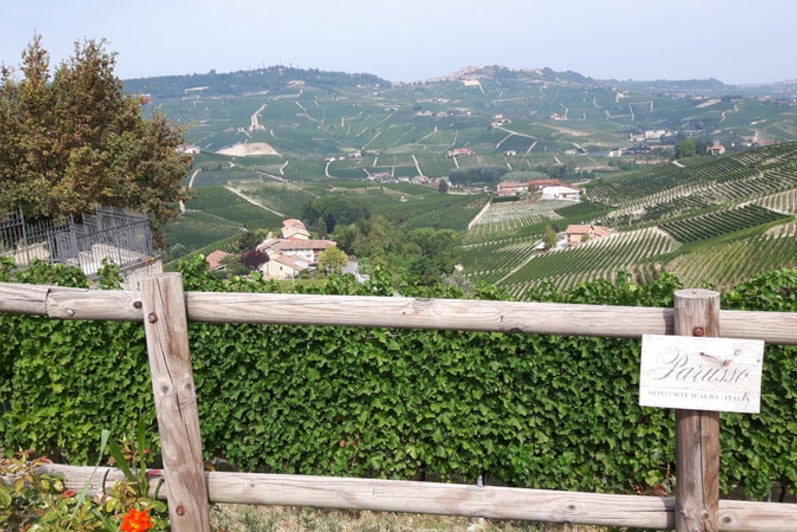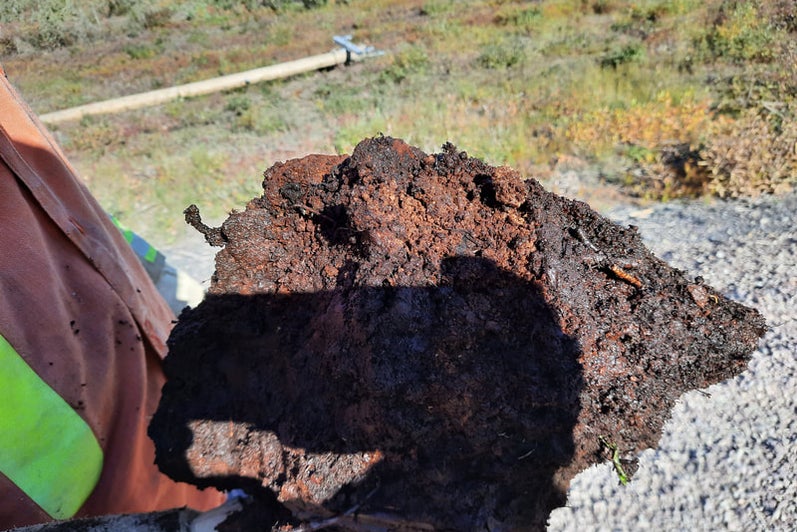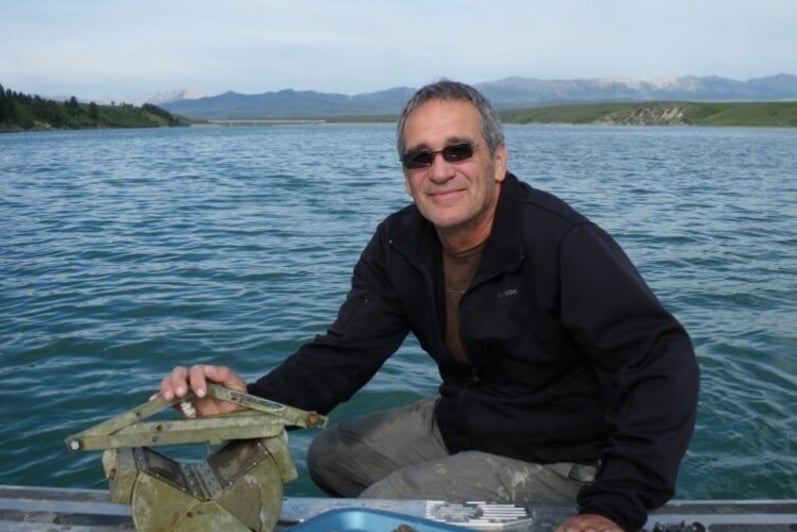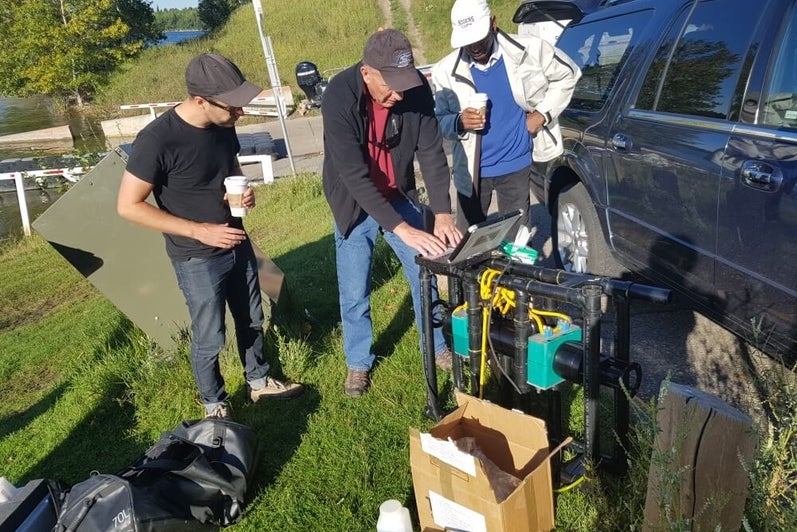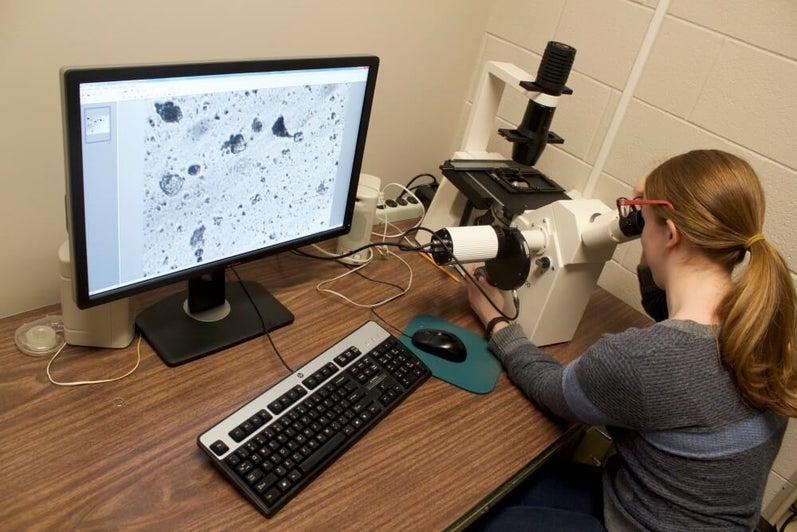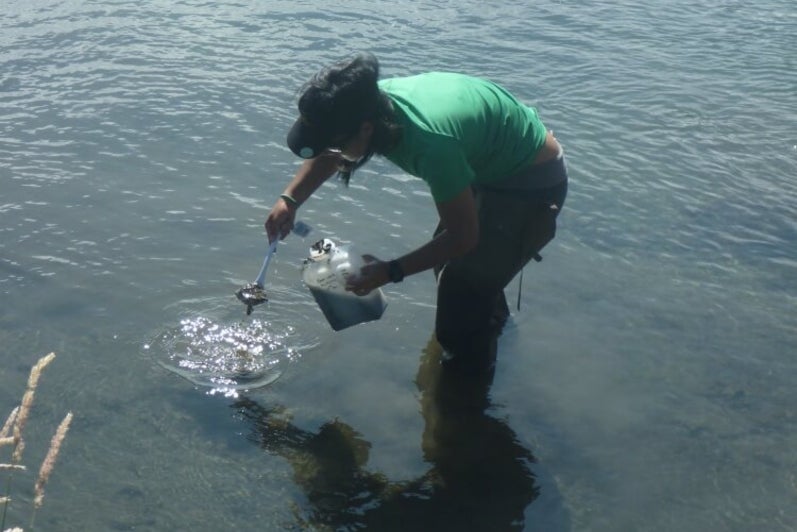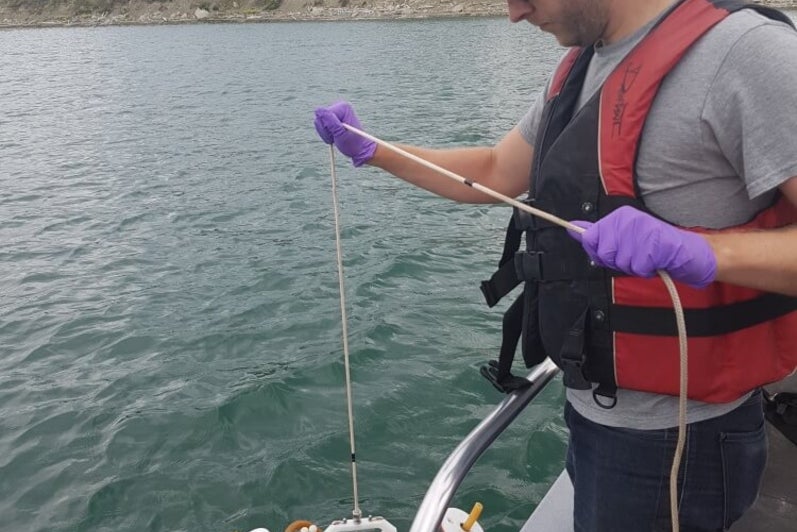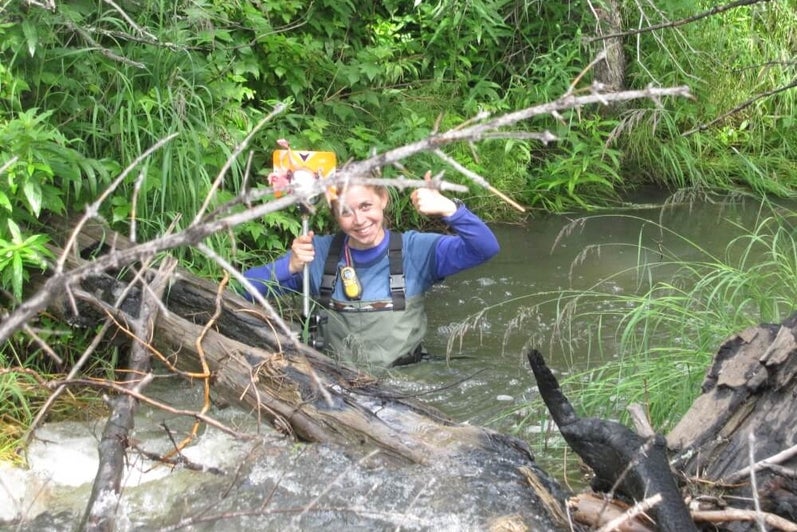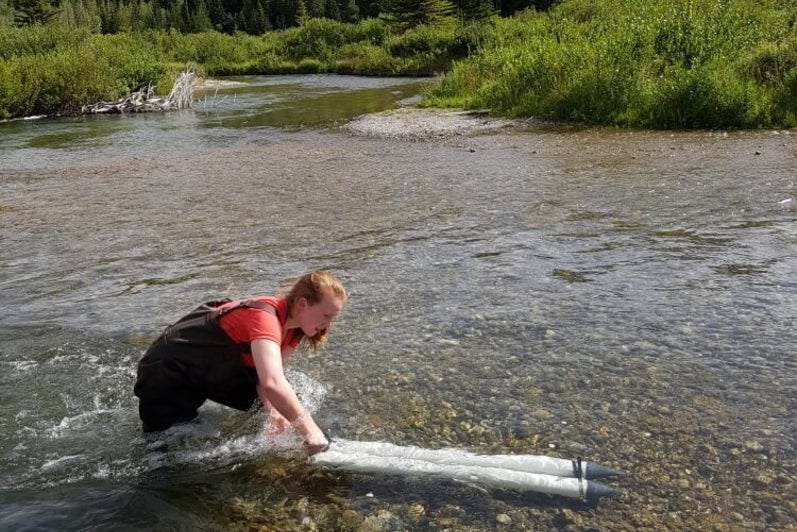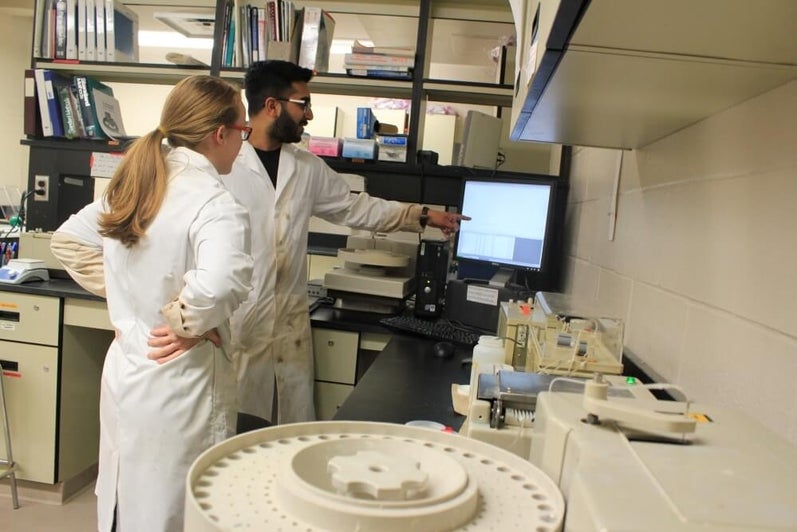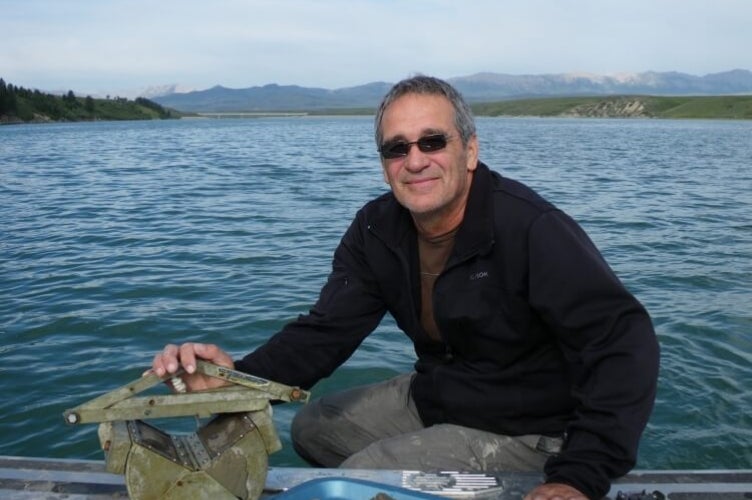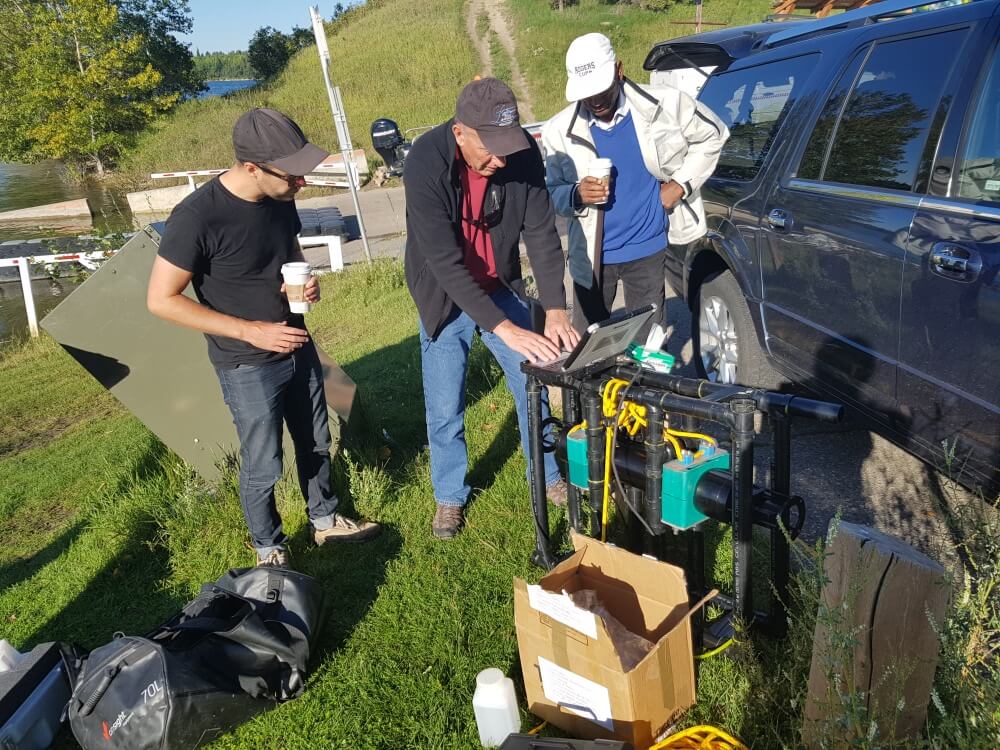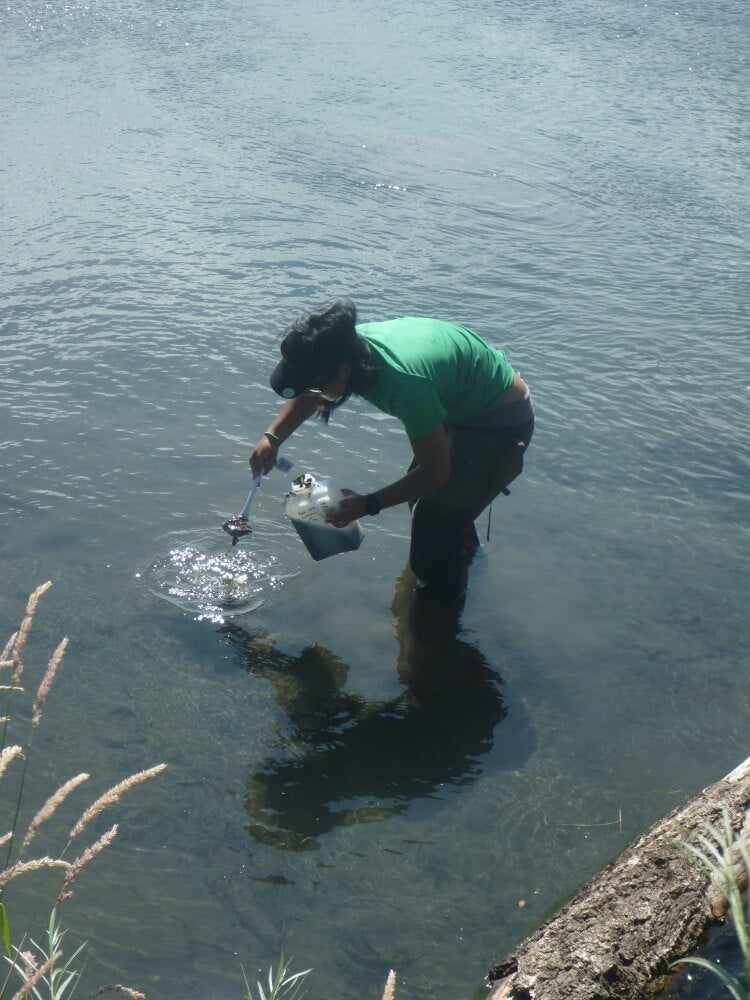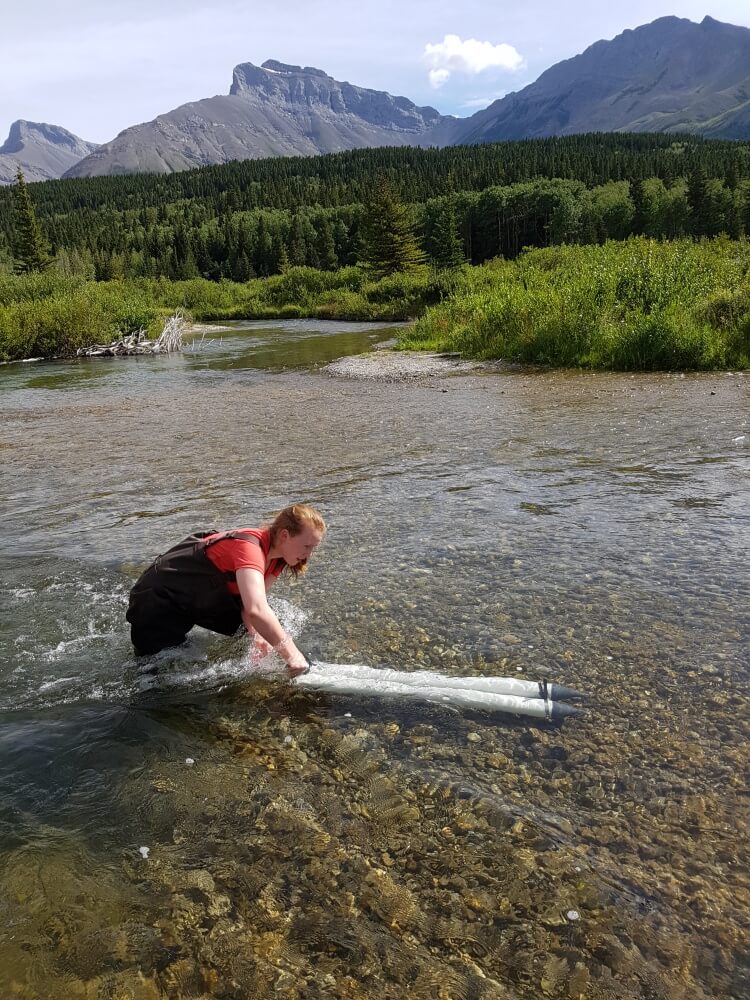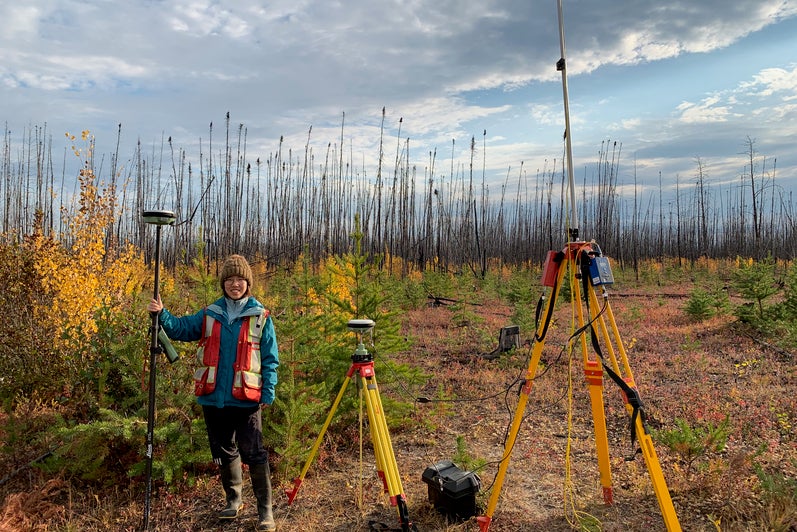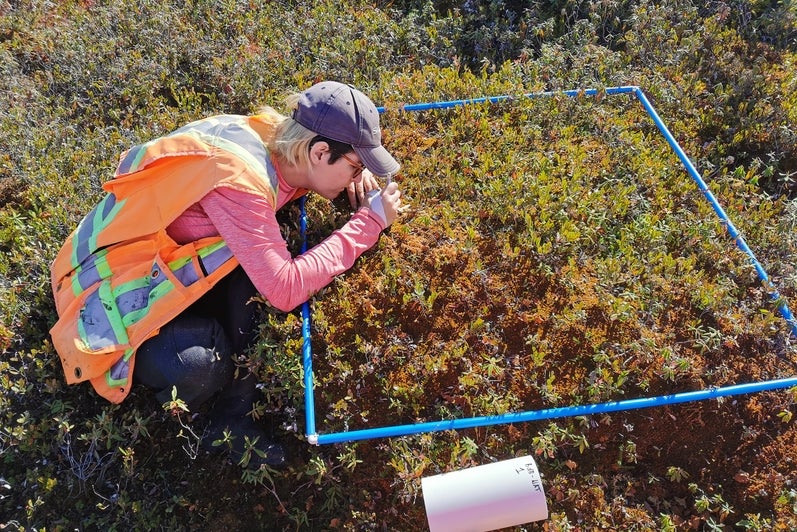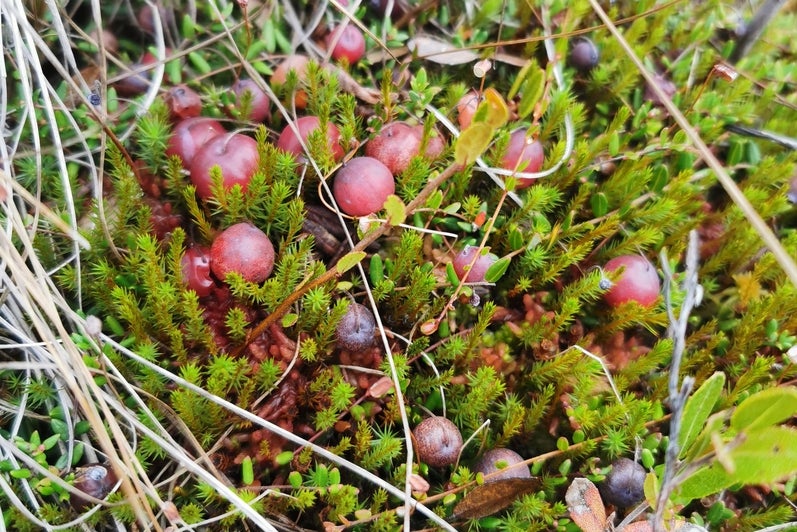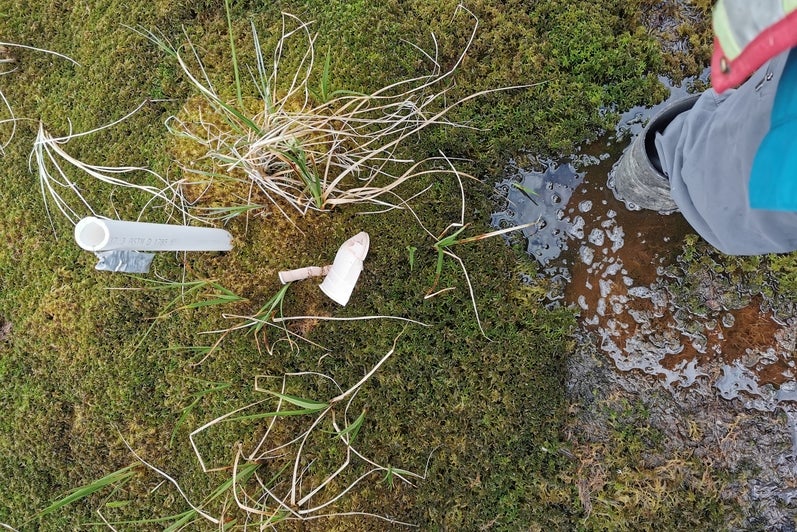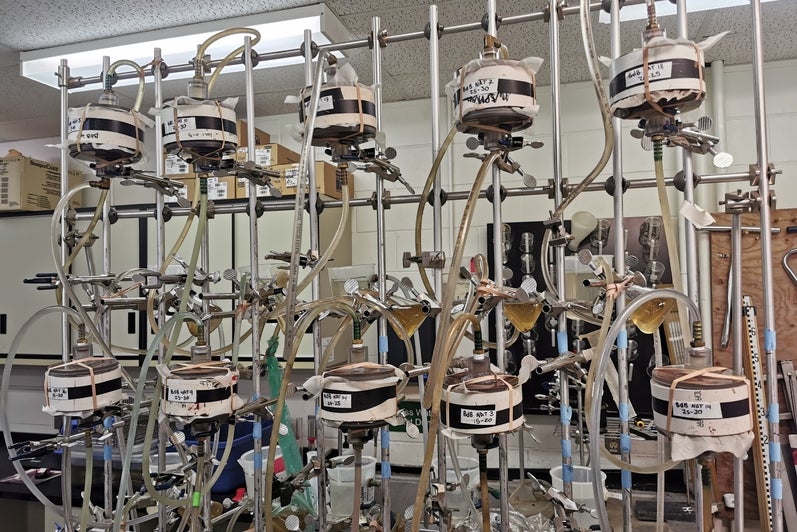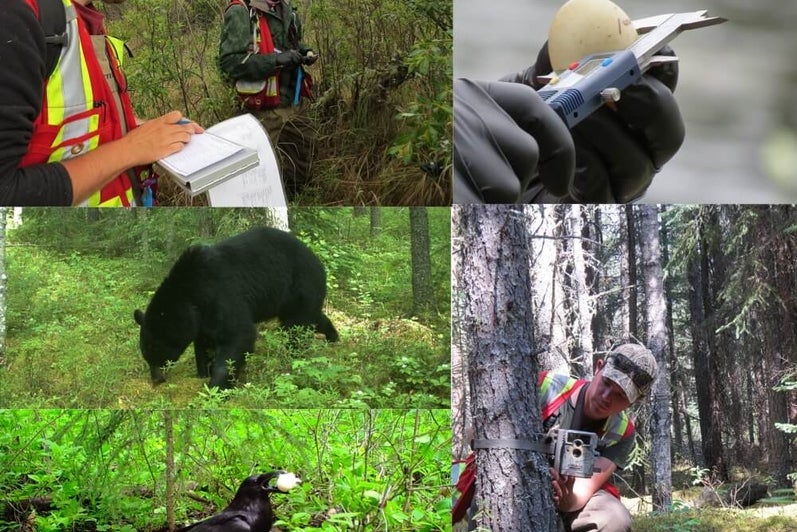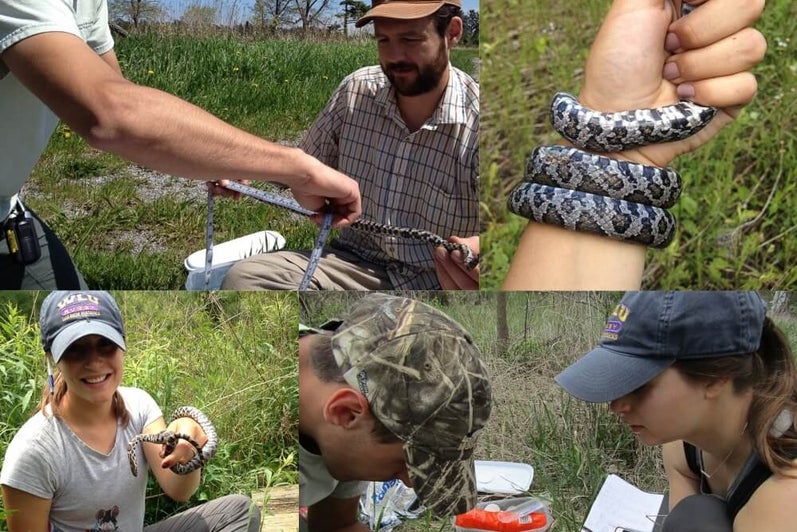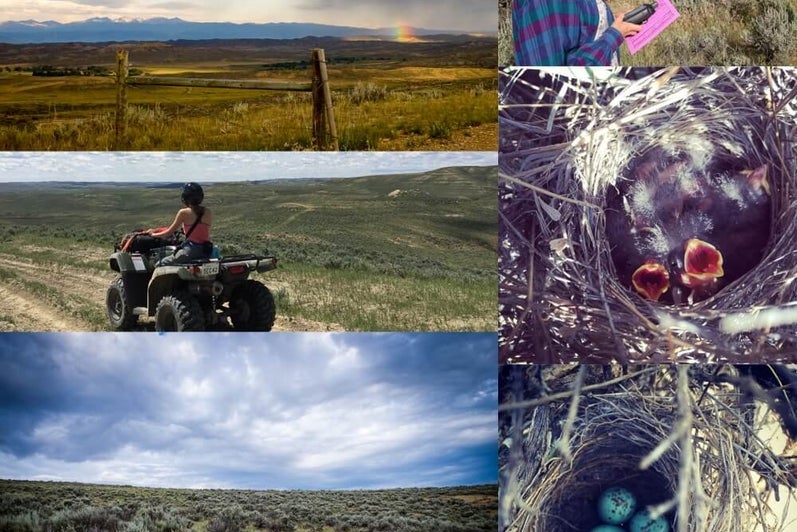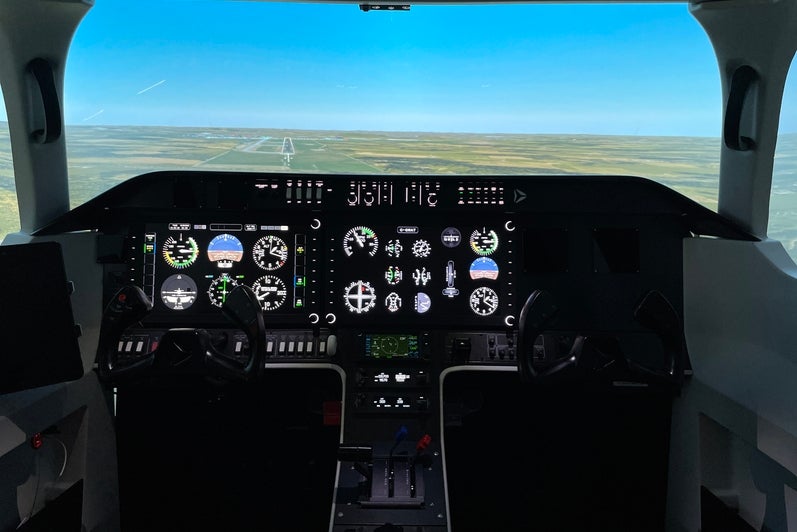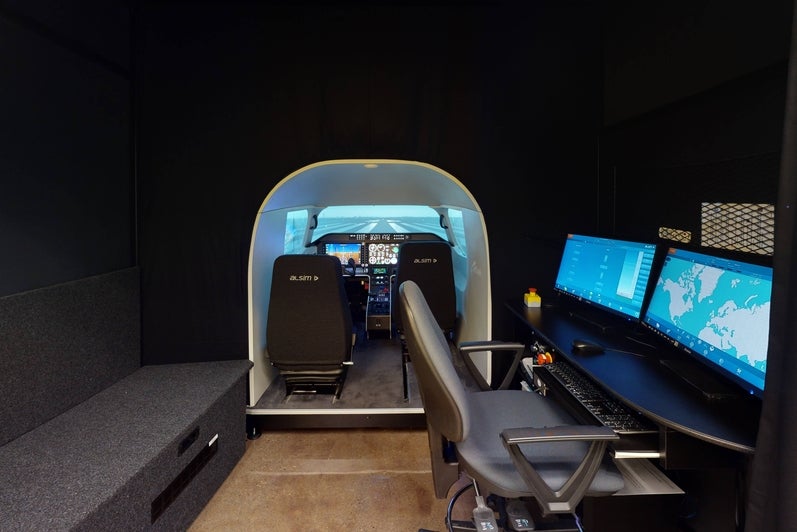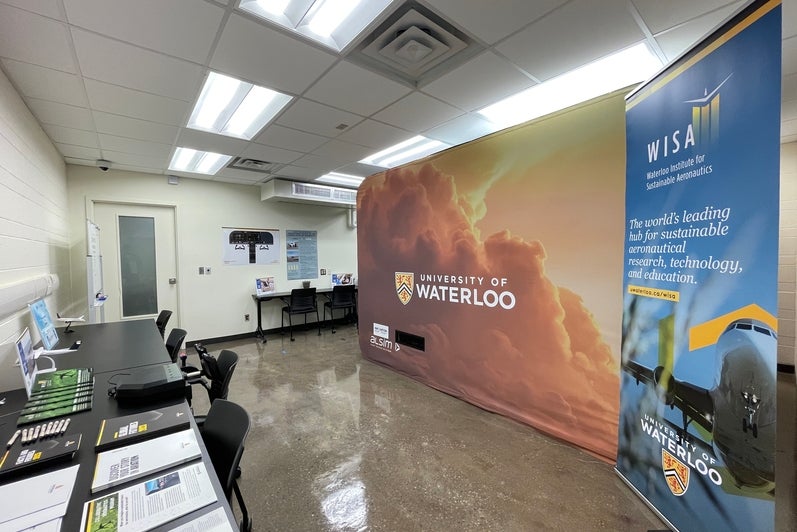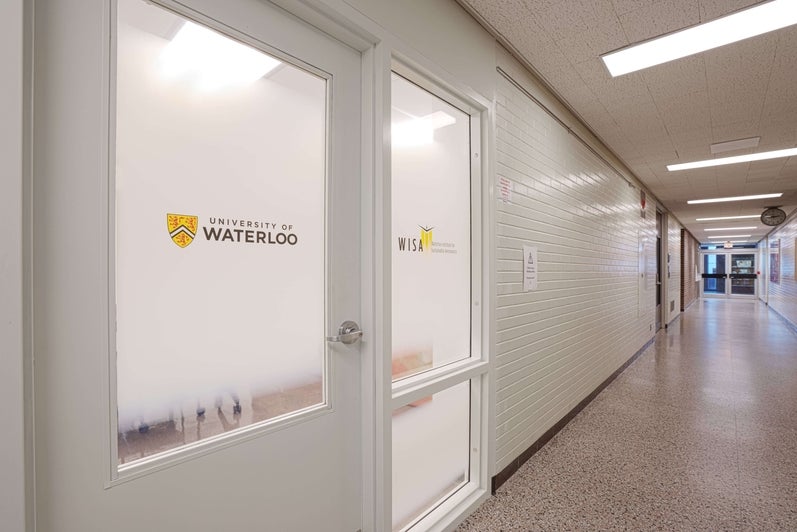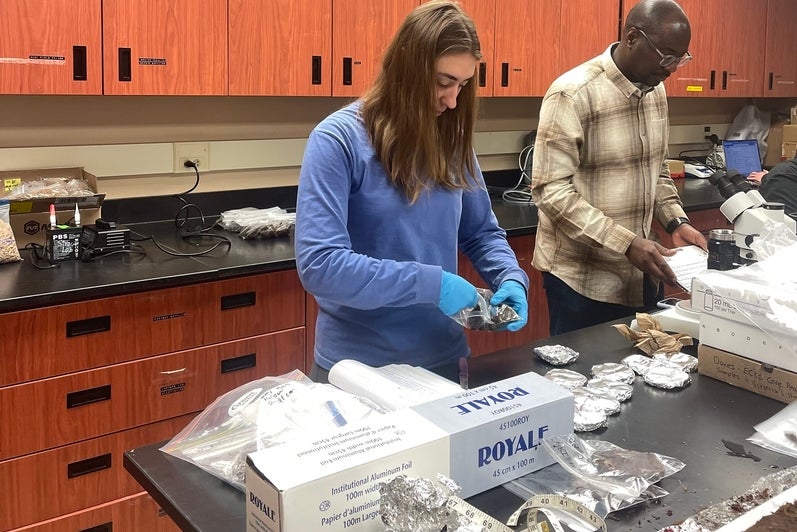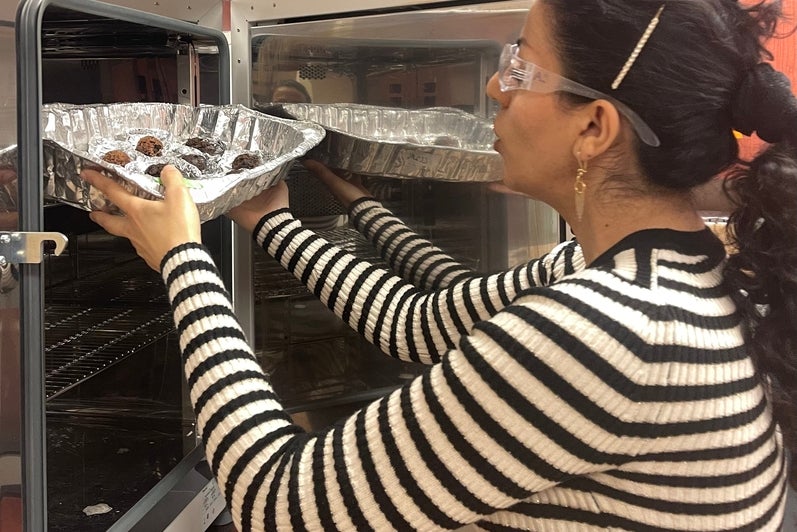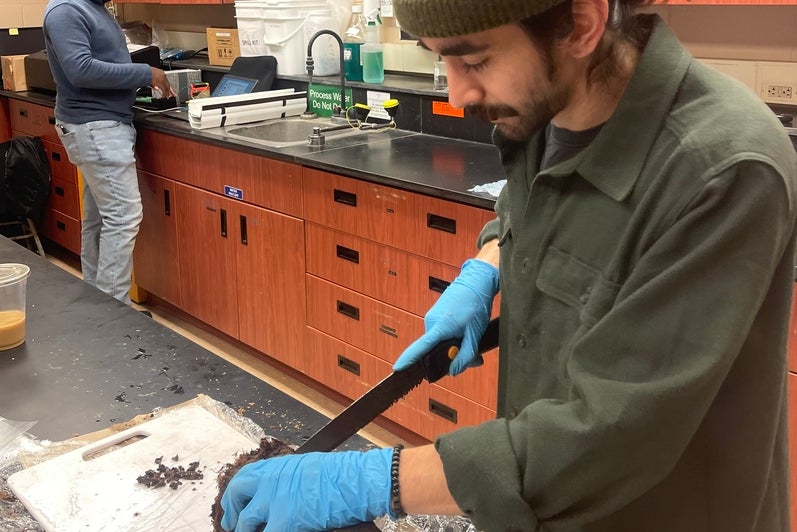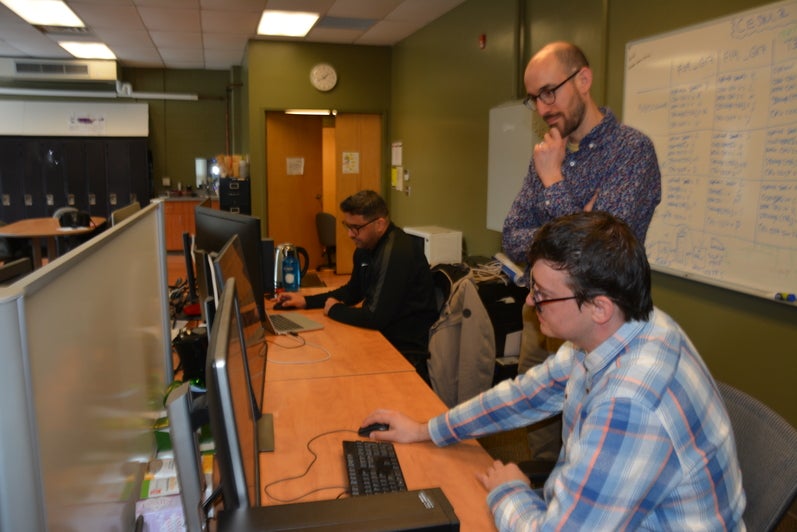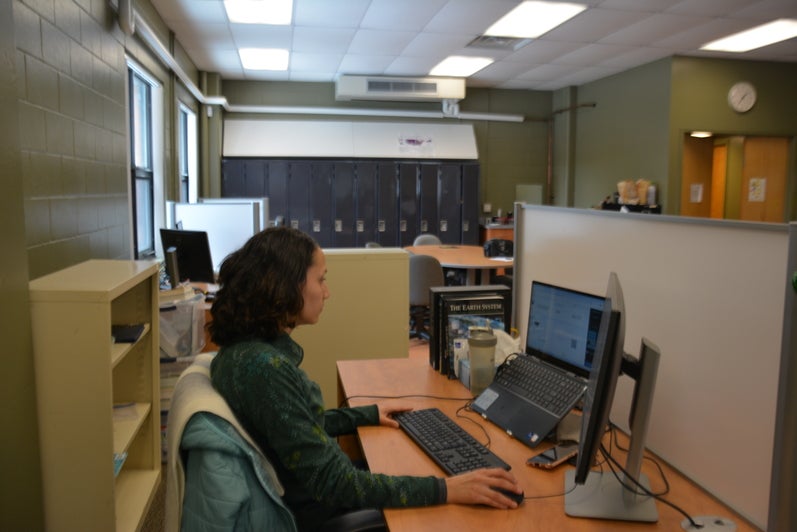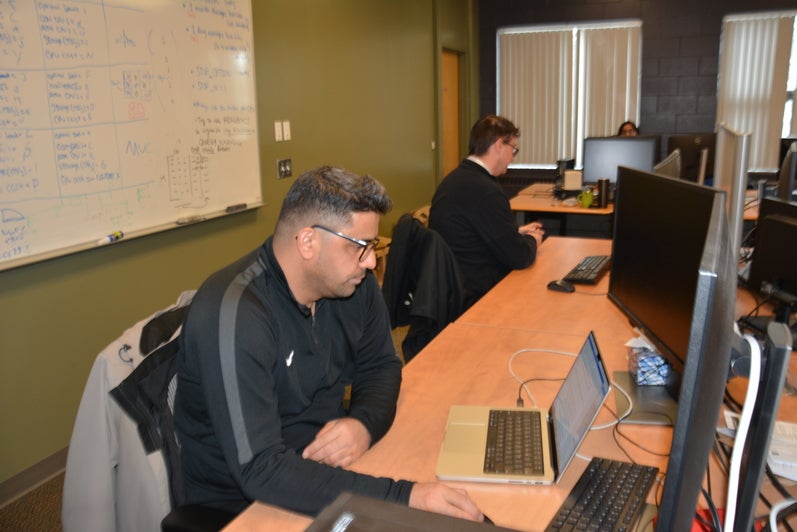
The Faculty of Environment is home to an array of state-of-the-art physical sciences research labs that support our researchers and students.
Explore the facilities
Biogeochemistry Lab (EV1 243)
Merrin Macrae
Department of Geography and Environmental Management
Research focus and activities
Our research group investigates water quality in runoff from agricultural fields and watersheds. We emphasize phosphorus losses in tile drainage and overland flow, year round. We are particularly interested in winter and snowmelt. We also investigate if and how best management practices (BMP) can be used to improve water quality and reduce nutrient losses in runoff.
We process and analyze soil, plant and water samples. We analyze for nutrients (nitrogen, phosphorus) and also major ions. Sometimes we do experiments in the lab using soil and plant collected from the field.
We are making a lot of progress on understanding the role of tile drainage in phosphorus losses from farm fields, and also understanding how important the non-growing season (October – April) is for annual phosphorus losses.
Fun facts
As a lab, we drink over 37 litres of coffee in a work week (I did the math, there are 10 of us), enough caffeine to stay productive.
The only clock in the lab doesn't work, instead we have sharpied: "it's always time for science" on it.
Professor Merrin Macrae and lab technician looking at results from ion chromatography instrument used for ion analysis of water samples from agricultural fields.
Lab technician looking at meteorological and hydrological data collected from agricultural fields site using field computer next to filtering manifold used for water samples.
Hydrological data from agricultural field site plotted using field computer next to filtering manifold used to process water samples collected for water quality and nutrient transport research from farms.
Students prototyping v-notch weir to collect surface water samples for agricultural water quality and nutrient transport research.
Co-op student using an autopipette, analytical chemistry is a key part in phosphorus and nitrogen research.
Conservation and Restoration Ecology Lab (EV1 243A)
Stephen Murphy
School of Environment, Resources and Sustainability
Research focus and activities
We focus is on conservation ecology, especially in parks and protected areas. We take an inclusive approach as projects include population and community ecology studies on different habitats (e.g., prairies, forests, wetlands, shorelines, rivers) and taxa (e.g., plants, fungi, herptiles, arthropods, annelids). We work on the larger socioecological issues involved in management and governance needed to provide a desirable and resilient ecosystem – we have worked with municipalities, NGOs, private sector partners, federal and provincial agencies, and world organizations such as the United Nations (UN).
Restoration ecology/resilient ecosystems frame our other major focus. Stephen Murphy has chaired the Society for Ecological Restoration of Ontario, organized several of the International Meetings of the Society for Ecological Restoration, and is Editor-in-Chief of the journal Restoration Ecology. Steve and his team have led or participated in over 1,500 restoration projects. We’ve restored functional aspects of novel and more historical ecosystems and restored prairies, forests, wetlands, shorelines, rivers, and meadows in rural and urban areas.
Did you know?
CaRE Lab members have worked in 139 countries.
PhD candidate Michael McTavish, observing the foraging behaviour of exotic earthworms in laboratory mesocosms.
PhD candidate Heather Cray, using a dissecting microscope to identify preserved plant samples from a restored prairie site.
Patricia Huynh, PhD Student, identifying benthic macroinvertebrate samples obtained from the Grand River watershed.
Cryosphere Remote Sensing Lab (EV2 1026)
Claude Duguay, Richard Kelly, Christine Dow
Department of Geography and Environmental Management
Research focus and activities
The Cryospheric Remote Sensing Research Facility (CRSRF) was established in 2009 by Professors Claude Duguay and Richard Kelly with funding obtained from the Canadian Foundation for Innovation and the Ontario Ministry of Research and Innovation.
Polarimetric ground-based scatterometer systems operating at Ku and X-band frequencies have been acquired to deepen our understanding of active microwave interactions with snow and ice properties. Our group is using the scatterometer systems and complementary field instruments to develop a rich understanding of radiative transfer and backscattering processes from snow and ice, and in the principles of snow and ice energy and mass balance processes. Graduate students are also being trained in the operation of automated weather stations with a suite of radiation and energy balance instruments, automatic ice profiler and snow depth systems as well as more traditional snow and ice field instruments such as snow tubes, ice corers and augers, density profilers and other standard snow survey techniques.
CRSRF provides the only Ku-/X-band scatterometer facility of its kind in North America.The infrastructure has previously been used in support of the CoReH2O satellite mission proposed to the European Space Agency.To date, the full suite of instruments has been deployed at several locations and sites (land, lake ice, sea ice) in Canada: Churchill, Manitoba; Resolute, Nunavut; and the Waterloo region.
Interesting fact
UW-Scat is well-travelled. It has been deployed in arctic and subarctic environments such as Resolute, Nunavut and Churchill, Manitoba. Within Ontario, it has been deployed in Maryhill, Tobermory, and Englehart. It is scheduled for deployment near Grand Mesa, Colorado and Inuvik, Northwest Territories in early 2017.
Hydrology Meteorology Research Lab (EV2 1033)
Rich Petrone/George Sutherland
Department of Geography and Environmental Management
Research focus and activities
Much of the research done in the lab is currently focusing on understanding the integrated ecohydrological behaviour of wetland and forest ecosystems, especially in the Western Boreal, Subarctic and Alpine regions, in the context of climate and landuse change.
Significant progress has been made in improving our understanding of the cumulative effects of landuse change and climate variability on hydrologic linkages in forest-wetland-pond systems in the plains region of the Western Boreal Forest. In particular: establishing the relative contributions of vegetation communities and landscape units to catchment scale evapotranspiration and greenhouse gas exchange; quantifying the effects of disturbance on evapotranspiration and greenhouse gas exchange, soil moisture distribution and lateral water movement between landscape units; and determining linkages/feedbacks between surface hydrological processes and carbon storage.
Over the past 5 years, significant research has been done applying what we have learned in these areas to large large-scale reclamation efforts, especially pertaining to oils sands development and mining, and conventional oil and gas exploration. Much of this research has contributed not only to the design of constructed systems (especially wetlands) but also to learning how best to evaluate the efficacy of reclamation strategies and success of landscapes post construction.
Recently, with collaborators at Western University, McGill University, Laurentian University and the Ontario Ministry of Natural Resources, the lab was awarded an NSERC Strategic Grant for an innovative program on peatlands and climate change.
Did you know?
We have one of the largest networks of Eddy Covariance installations owned by an individual group, with 15 study sites in operation across the country; from farmland in Southern Ontario to wetlands and forests across Canada's Boreal zone and the Rocky Mountains. The lab is a fully equipped and certified calibration facility.
George S. (Project Manager) and Adam G. (MSc student) set up a shaker table filled with water samples that will be processed for nitrogen and phosphorous concentrations.
Tristan G.H (MSc student) processes soil samples for the determination of saturated hydraulic conductivity, an important property of a soil that describes the ease at which fluid moves through pores and fractures.
George S. (Project Manager) and Dylan H. (Research Assistant) process vegetation samples collected from the field using an area meter.
Soil samples soaking in a water bath in preparation for the determination of physical parameters, such as bulk density and specific yield, which are important characteristics of soils used in a variety of calculations and models.
Soil Ecosystem Dynamics Lab (EV2 1023)
Maren Oelbermann
School of Environment, Resources and Sustainability
Research focus and activities
Signature research areas include sustainable agriculture and agroforestry, soil health, biochar, greenhouse gas emissions, soil carbon sequestration, climate change impact on plants and soil, restoration/rehabilitation.
The goal at Soil Ecosystem Dynamics Lab (SED) is to enhance our knowledge on the transformations and processes that take place in the soil, and to examine the relationship between plants, soil and the atmosphere. By doing so, we hope to further understand how to use natural and managed ecosystems help mitigate climate change through carbon sequestration, by minimizing greenhouse gas emissions, and ensuring the long-term security of food and soil.
A new research interest in SED is a focus on biochar and its use as an agricultural soil amendment. We have launched the largest replicated biochar field trials in Ontario in 2016.
The SED research group frequently collaborates with international, national and local scholars that come to use our lab facilities. Infrastructure in the SED laboratory also supports other researchers within the Faculty of Environment. For further information on individual research projects, graduate students, publications and graduate student opportunities see the SED Lab website.
PhD candidate Shefaza Esmail using the evacuation manifold to evacuate vials for greenhouse gas sampling.
Sediment and Water Quality Lab (EV2 1022B)
Mike Stone
Department of Geography and Environmental Management
Research focus and activities
Professor Stone’s research program is directed towards the study of land use change and its impact on surface water quality in natural and built environments. A particular focus of his research is to quantify and model the source, transport and fate of sediment associated contaminants in aquatic environments. He has conducted research in regions such as the Great Lakes Basin, Alberta, the Northwest Territories and China. Over the past 10 years his research has specifically examined the effects of wildfire on the mobility and downstream propagation of sediment-associated contaminants.
The Sediment and Water Quality lab has the capacity to analyze a range of nutrients and contaminants typically in the aqueous and solid phase. An Empix Image Analysis System is used to characterize the particle size distribution and fractal properties of cohesive sediment.
Professor Stone is the Downstream Propagation Node Leader of the award winning Southern Rockies Watershed Project.
Preparing the LISST (linear, integrated solid-state tube) to sample cohesive sediment in the Glenmore Reservoir.
Wetlands Hydrology Lab (EV2 1029)
Jonathan
Price,
James
Sherwood
Department
of
Geography
and
Environmental
Management
Research focus and activities
The Wetlands Hydrology Laboratory (WHL) is one of the foremost authorities on peatland science in the world, with research interests that span a wide range of disciplines, including (but not limited to) the fields of hydrology, hydrogeology, contaminate transport, reclamation, and restoration.
Within Canada, the WHL engages in leading edge research across the country. Eastward, along the fog covered coasts of the peaty Acadian Peninsula, the WHL investigates the effects of horticultural extraction on peatland restoration trajectories. Heading north towards the second largest wetland complex in the world, the James Bay Lowlands of Northern Ontario serves as ground zero for research investigating the effects of diamond mine dewatering on peatland ecohydrologic function and mercury dynamics. Exploring the efficacy of peatlands as natural wastewater treatment facilities in remote locations is also an important research interest in this region. Westward, within the subhumid Boreal Plains of north eastern Alberta, the WHL works closely with industry in the design and monitoring of one of the oil sands first man-made watersheds. Testing the feasibility of developing a self-sustaining, carbon accumulating peatland in the post-mined landscape is just one example of how the WHL pushes the limits in the field of wetland research.
Innovation at the WHL is fueled by our interdisciplinary team of students, technicians, research associates, and collaborators and is supported by our state-of-the-art ‘wet’ laboratory and numerous research sites across the country and abroad.
Interesting fact
In 2010 Professor Price, head of the WHL, developed the first conceptual model of a self-sustaining peatland to be built within the post-mined oil sands landscape. Today, the WHL and its research partners continue the intensive, long-term monitoring of the oil sands first artificial wetland designed from this concept that, as of 2016, is in its 5th year of operation.
*Please click on the first image below to open the photo gallery in full resolution.
Suyuan setting up Leica GS14 Differential GPS unit measuring well and piezometers heights in Poplar fen, a reference fen for the Nikanotee constructed fen, AB.
Tasha Leigh performing a vegetation survey in a natural site, as a reference for Bois-des-Bel restoration project, QC.
Wildlife and Molecular Ecology Lab (EV2 1007)
Brad Fedy
School of Environment, Resources and Sustainability
Research focus and activities
Research in the Wildlife and Molecular Ecology Lab examines the factors that influence the fitness of animal populations at multiple scales – from genes to landscapes. The impetus for most of our research emerges from important conservation issues; however, we also endeavour to answer general ecological questions to improve concepts and theory in ecology and evolution. We focus on wildlife questions examining habitat selection, landscape genetics, population trends and social behaviour.
We integrate across disciplines in Ecology which often requires the use multiple tools to investigate priority research questions. In addition to our lab-based genetics research, we use the tried and true techniques of field-based research in wildlife capture, marking, and tracking. We also use multiple modelling approaches to understand the data we have collected and generated including Bayesian statistics, mixed-models, circuit theory, and machine-learning approaches. Much of the research in the lab focuses on a diverse array of avian species including grouse, waterfowl, raptors, and passerines. However, we do not limit our research to only birds and have also conducted research on herptiles, fish, insects, and mammals. Finally, we work closely with our management partners to ensure the relevance of our research to conservation and management actions.
Interesting fact
Our funding and research partners include the U.S. Bureau of Land Management, U.S. Fish and Wildlife Service, U.S. Department of Agriculture, Wyoming Game and Fish Department, The National Audubon Society, The Nature Conservancy, Ducks Unlimited Canada, Wildlife Habitat Canada, Ontario Ministry of Natural Resources and Forestry, and Parks Canada.
WISA Sim Lab
Suzanne Kearns
Department of Geography and Environmental Management
Research focus and activities
The Sim Lab plays a pivotal role in advancing research at the Waterloo Institute for Sustainable Aeronautics (WISA).
WISA catalyzes research under the three pillars of sustainability – environmental, social, and economic to support the air transport sector. Working together with partners in government and industry, our members combine their strengths to create meaningful, long-term solutions:
- Building equitable, diverse, and inclusive workforces, communities, and access to mobility
- Reducing and eliminating the harmful environmental impacts of aeronautics
- Supporting a future-ready workforce and long-term economic growth
A key piece of shared infrastructure, the Sim Lab serves as a hub for cutting-edge aviation research. The facility houses an ALSIM AL250 flight simulator that can be reconfigured to represent several types of aircraft used in pilot training, including single-engine, complex single-engine, and multi-engine aircraft.
Examples of previous studies include skill development in pilots, vision requirements for flight, and new technologies for pilot training.
Interesting fact
WISA welcomes researchers from all six faculties at the University of Waterloo. Any WISA Member can submit a request to use the flight simulator for their research.
Wetlands Soils and Greenhouse Gas Exchange Lab (EV2 1027)
Maria Strack
Department of Geography and Environmental Management
Research focus and activities
Research in the Wetland Soils and Greenhouse Gas Exchange Lab focuses on quantify greenhouse gas (GHG) fluxes from a range of natural and disturbed wetland ecosystems. We investigate the impact of climate change, industrial disturbance and restoration on wetland soils and biogeochemical cycling.
In the lab we process biomass, soil and water samples to better understand controls on wetland GHG exchange. We also analyze air samples to determine GHG concentration using infrared gas analyzers, a gas chromatograph and fast methane analyzer. These concentrations are then used to determine rates of GHG emissions to or removals from the atmosphere by wetlands.
Our research group conducts a lot of its research with the oil industry investigating how oil extraction in the boreal forest impacts peatland GHG fluxes, how to mitigate these impacts and how to restore wetlands following disturbance.
Fun fact
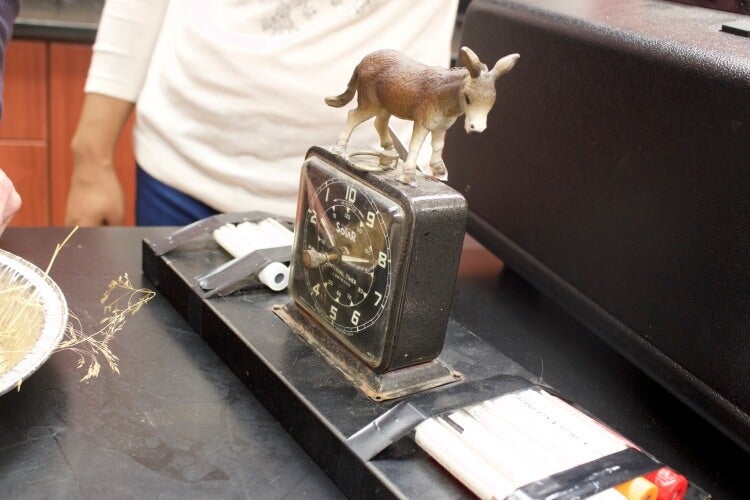
Every year we give out our "Swamp Donkey" award to the member that has made the biggest research error. It is good to remember that we learn from both success and failure in science and this is a fun way to support each other (even when things go wrong!).
Climate modeling and analysis group
Chris Fletcher
Department of Geography and Environmental Management
Research focus and activities
Our research group conducts experiments on the global climate system, to discover what future climate change might look like in Canada and the Arctic. We run our experiments using computer models, which are numerical laboratories that provide a safe and controlled means of investigating how the climate system responds to increasing greenhouse gases, all from the comfort of our desks. We are one of only a handful of University-based research teams using global climate models, and our team of postdocs, graduate and undergraduate students gain hands-on experience with using and perturbing these models. The main modelling system we use is the Community Earth System Model built by the National Center for Atmospheric Research in Boulder, Colorado, but we also have expertise with a global land surface model developed by Environment and Climate Change Canada called the Canadian Land Surface Scheme (CLASS).
The group is engaged in diverse projects investigating global climate variability in change, with a focus on improving our fundamental understanding of dynamics and processes. Through funding from the CanSISE network, supported by the NSERC Climate Change and Atmospheric Research program, we have recently provided new insight into the important role played by surface snow cover in climate change, particularly over forested regions of the northern hemisphere, such as those in northern Canada. Supported by Prof Fletcher's NSERC Discovery Grant, we also focus on the dynamics of atmospheric teleconnections, climate phenomena that link variations in North American weather and climate to far-away regions of the Earth in the tropical oceans. A third strand of our research involves translating future projections from global climate models to specific geographic regions (such as recent work producing future climate projections for Waterloo Region), or to specific socio-economic applications (such as our recent work quantifying the potential impact of climate change on highway pavement maintenance costs).
Interesting facts
Climate models are incredibly complex pieces of computer software, typically totalling more than one million lines of code, and occupying some of the fastest supercomputers in the world. Our group runs its simulations on the Compute Canada SciNet systems, located in west Toronto. Climate models evolved from numerical weather forecasting models, and the first simulations of global climate change were completed in the late 1960s. Amazingly, these first simulations projected about the same amount of future climate change as our most sophisticated models do today, demonstrating the science of climate change has been known and understood for a very long time.
